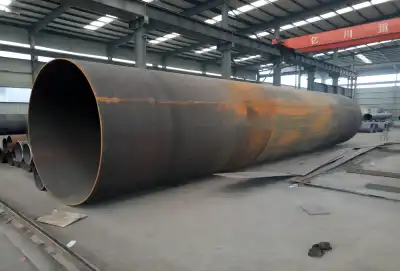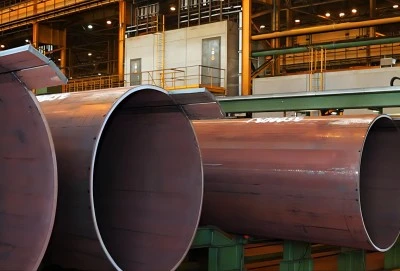Large diameter welded pipes are essential components in various industries, including oil and gas, water transportation, and construction. These pipes are known for their durability, strength, and versatility. However, many project managers and engineers often wonder about the customization options available for these pipes.
|
|
|
What Customization Options Are Available for Large Diameter Welded Pipes?
Large diameter welded pipes offer a wide range of customization options to suit diverse project needs. These options can be broadly categorized into several key areas:
1. Material Selection
The choice of material is crucial in determining the pipe's performance and longevity. Large diameter welded pipes can be manufactured using various materials, including:
- Carbon Steel: Ideal for general-purpose applications due to its strength and cost-effectiveness.
- Stainless Steel: Offers excellent corrosion resistance, making it suitable for harsh environments.
- Alloy Steel: Provides enhanced strength and heat resistance for high-pressure and high-temperature applications.
- Duplex Stainless Steel: Combines the properties of austenitic and ferritic steels, offering high strength and corrosion resistance.
The selection of material depends on factors such as the intended use, environmental conditions, and budget constraints.
2. Welding Techniques
Different welding techniques can be employed based on the pipe's specifications and intended use:
- Submerged Arc Welding (SAW): Suitable for thick-walled pipes and high-pressure applications.
- Electric Resistance Welding (ERW): Ideal for smaller diameter pipes and lower pressure requirements.
- Spiral Welding: Used for large diameter pipes with continuous spiral seams.
The choice of welding technique affects the pipe's strength, reliability, and overall performance.
3. Surface Treatments
Various surface treatments can be applied to enhance the pipe's properties:
- Galvanization: Provides corrosion resistance by coating the pipe with a layer of zinc.
- Epoxy Coating: Offers protection against chemical corrosion and abrasion.
- Powder Coating: Provides a durable, attractive finish suitable for exposed pipes.
These treatments can significantly extend the lifespan of large diameter welded pipes and improve their resistance to environmental factors.
How Does Pipe Diameter and Wall Thickness Customization Meet Different Project Needs?
The customization of pipe diameter and wall thickness is crucial in meeting specific project requirements. Let's explore how these parameters can be tailored:
1. Pipe Diameter Customization
Large diameter welded pipes can be manufactured in a wide range of diameters, typically from 16 inches (406 mm) to 100 inches (2540 mm) or even larger. The choice of diameter depends on several factors:
- Flow Rate Requirements: Larger diameters allow for higher flow rates, which is essential in applications such as water distribution or oil transportation.
- Pressure Considerations: Smaller diameters can handle higher pressures more efficiently, making them suitable for high-pressure applications.
- Installation Constraints: The available space for installation may limit the maximum pipe diameter that can be used.
By customizing the pipe diameter, engineers can optimize the system's performance while adhering to project constraints.
2. Wall Thickness Customization
The wall thickness of large diameter welded pipes can be tailored to meet specific strength and pressure requirements. Factors influencing wall thickness include:
- Internal Pressure: Higher internal pressures require thicker walls to ensure structural integrity.
- External Loads: Pipes subjected to significant external loads, such as soil pressure in buried applications, may require increased wall thickness.
- Corrosion Allowance: Additional wall thickness can be specified to account for potential material loss due to corrosion over time.
Customizing wall thickness allows for the optimal balance between strength, weight, and cost-effectiveness.
3. Length Customization
Large diameter welded pipes can be manufactured in various lengths to suit project requirements:
- Standard Lengths: Typically ranging from 40 to 60 feet (12 to 18 meters).
- Custom Lengths: Pipes can be produced in longer or shorter lengths based on transportation and installation constraints.
- Double Random Lengths: Some manufacturers offer pipes in double random lengths, which can reduce the number of field welds required during installation.
Customizing pipe length can significantly impact installation efficiency and overall project costs.
Can Coatings and Linings Be Customized for Large Diameter Welded Pipes?
Yes, coatings and linings for large diameter welded pipes can be extensively customized to meet specific project requirements. These customizations play a crucial role in enhancing the pipe's performance, longevity, and suitability for various applications.
1. External Coatings
External coatings provide protection against corrosion, mechanical damage, and environmental factors. Customization options include:
- Fusion Bonded Epoxy (FBE): Offers excellent corrosion protection and is widely used in the oil and gas industry.
- Three-Layer Polyethylene (3LPE): Provides superior mechanical protection and is suitable for buried pipelines.
- Polyurethane Coatings: Offer high abrasion resistance and are ideal for offshore applications.
- Concrete Weight Coating: Provides negative buoyancy for subsea pipelines and mechanical protection.
The selection of external coating depends on factors such as soil conditions, operating temperature, and installation method.
2. Internal Linings
Internal linings protect the pipe from corrosion and erosion caused by the transported medium. Customization options include:
- Epoxy Linings: Provide excellent chemical resistance and are suitable for various applications.
- Cement Mortar Lining: Commonly used in water distribution systems to prevent corrosion and improve flow characteristics.
- Polyurethane Linings: Offer high abrasion resistance and are suitable for slurry transportation.
- Glass Flake Linings: Provide exceptional chemical resistance for highly corrosive environments.
The choice of internal lining depends on the nature of the transported medium, operating conditions, and desired service life.
3. Specialized Coatings
In addition to standard coatings and linings, specialized options are available for unique requirements:
- Thermal Insulation Coatings: Help maintain temperature control in high-temperature or cryogenic applications.
- Anti-Fouling Coatings: Prevent the buildup of marine organisms in offshore applications.
- Noise Reduction Coatings: Minimize noise transmission in urban pipeline systems.
These specialized coatings address specific challenges and enhance the overall performance of large diameter welded pipes in diverse operating environments.
Contact Longma
Large-diameter welded pipes offer extensive customization options to meet diverse project requirements. From material selection and welding techniques to diameter, wall thickness, and coating customizations, these pipes can be tailored to optimize performance, durability, and cost-effectiveness. The ability to customize coatings and linings further enhances their versatility, making them suitable for a wide range of applications across various industries.
If you're looking for high-quality, customized large diameter welded pipes for your project, look no further than Longma Group. Our team of experts can help you navigate the various customization options and provide tailored solutions to meet your specific needs. Contact us today at info@longma-group.com to discuss your project requirements and experience the Longma difference in large-diameter welded pipe solutions.














